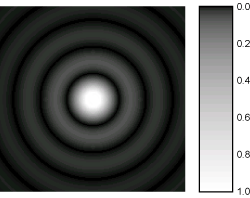Several times, I talked about the limitation to photo image quality by light diffraction but I failed to go into the details. To the general request of one reader who asked, I will try to give some explanations to better understand why the digital photographer must absolutely take that into account to make better pictures and to choose its camera.
 The first thing to know is that light diffraction is a very general phenomenon and quite natural. It’s been a long time already that scientists and engineers noticed that -on the one hand- light rays are slightly deflected while running through a very small orifice and -on the other hand- two light rays can interact with each other on the condition that they are have very paths nearly perfectly parallel. This is even one of the most significant and founding elements of quantum physics. When you combine both those phenomenons, you will notice that light going through a very small opening like camera lens diaphragm will produce not exactly the expected neat circle but a more irregular and circular shape that you can see in the illustrative figure that goes along this paragraph: Usually named an Airy disk or Airy disc.
The first thing to know is that light diffraction is a very general phenomenon and quite natural. It’s been a long time already that scientists and engineers noticed that -on the one hand- light rays are slightly deflected while running through a very small orifice and -on the other hand- two light rays can interact with each other on the condition that they are have very paths nearly perfectly parallel. This is even one of the most significant and founding elements of quantum physics. When you combine both those phenomenons, you will notice that light going through a very small opening like camera lens diaphragm will produce not exactly the expected neat circle but a more irregular and circular shape that you can see in the illustrative figure that goes along this paragraph: Usually named an Airy disk or Airy disc.
As a matter of fact, the size of the Airy disc can be computed relatively easily and only depends on the opening of the diaphragm where light goes through.
| diaphragm | diameter of the Airy disc |
| f/1.4 | 1.9 µm |
| f/2.8 | 3.8 µm |
| f/5.6 | 7.5 µm |
| f/8 | 10.7 µm |
| f/11 | 14.8 µm |
| f/16 | 21.5 µm |
| f/22 | 29.5 µm |
| f/32 | 42.9 µm |
| f/64 | 85.9 µm |
As this is only happening at the microscopic scale, you could think that this has no importance. But there is an additional difficulty for the digital photographer: Silicon-based image sensors are really working at this scale. For example, here are the sizes of some of the common images sensors on the market:
- APS-C sensor (1:1.5 crop factor / Sony SLR) of 6 mega-pixels: 8 µm
- APS-C sensor (1:1.6 crop factor / Canon SLR) of 8 mega-pixels: 6.5 µm
- APS-C sensor (1:1.6 crop factor / Canon SLR) of 12 mega-pixels: 5.3 µm
- Full Frame sensor of 12 mega-pixels (Canon 5D): 8.5 µm
- Full Frame sensor of 24 mega-pixels (Sony Alpha 900): 6 µm
- 1/2,5″ sensor of 8.2 mega-pixels (HP Photosmart R937 point-and-shoot): 1.7 µm
As you can notice all cameras are not born equal from this point of view. For the same number of pixels, Full Frame sensors have notably larger pixels than APS-C cheaper SLR cameras. Point and shoot compact cameras are in a completely different range. And phone cameras are pushing the lower limit of technology for smaller sensors (and correspondingly small pixels).
When you compare the values from the table of Airy circle sizes and the size of the pixels of your photo camera, you easily understand that closing the diaphragm of your top-notch lens is not enough to produce super-crisp images out of your brand new 12-mega-pixel camera: a 12MP Canon SLR will hit the Airy disc size as soon as you close down to f/5.6/; The images do not immediately become bad, but your pixels are not used at their best. And, sometimes, you wonder why you don’t get better results than from the older camera still in your bag.
A good algorithm of image correction may compensate part of this problem (as this phenomenon is very predictable and easy to modelize with computers, it is relatively easy to counter-act with software), but there limits to what firmware can do in our cameras, too. The situation is simply desperate with the smallest sensors of small point-and-shoot cameras and phone cameras. More pixels bring them nothing except bigger images files on Flash cards.
On the contrary, camera manufacturers firmly aim at larger sensors (so-called Full Frame sensors) in order to compensate these issues. This is what is driving the current rush to Full Frame at Canon, Nikon, Sony and the others despite the still prohibitive cost of the huge chunks of silicon used at the heart of these photo cameras.
Of course, do not refrain from closing the diaphragm to improve the depth of field of your image, but keep in mind the magnitude order of the limit diaphragms of your camera in order not to be surprised by the appearance of some diffraction in some of your images.
Additional information:
- Diffraction & photography, at Cambridge in color,
- Airy disk, at Wikipedia.

Leave a Reply